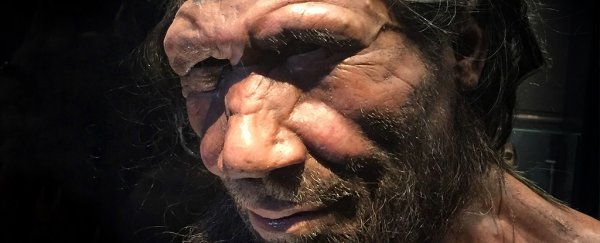A femur discovered in a cave in southwestern Germany has provided researchers with firm evidence that a small population of humans left Africa and then vanished, long before the big migration that saw humans populate the globe.
Signs of this mysterious early migration remained in the DNA of the Neanderthal who left the leg bone behind, revealing not only a previous tryst between the two hominin populations, but a sign that Neanderthals were far more diverse than we thought.
A team of scientists led by the Max Planck Institute for the Science of Human History and the University of Tübingen in Germany used the DNA from the femur's mitochondria to determine its relationship with other Neanderthals and modern humans.
Neanderthal and human history is a little complicated. So stick with us.
Neanderthals and huma'ns are regarded as close cousins, either under the same species of Homo sapiens or a closely related species Homo neanderthalis.
Mitochondria – our cells batteries – contain a set of genes separate from the DNA bunched up inside our nucleus. Since mitochondrial DNA mutates in a fairly predictable, conserved fashion, we can measure and map its mutations to get a good idea of when two populations last shared them.
Differences between our mitochondrial genes suggest we last shared a common ancestor a little over 400,000 years ago, though previous studies on nuclear DNA had estimated a split as far back as nearly 800,000 years ago.
Another group of human cousins dubbed the Denisovans also split off from a group of Neanderthals roughly 400,000 to 450,000 years ago before they went wandering the Earth.
The thing to note is Denisovans have nuclear DNA that matches Neanderthals' DNA more than our own. Which makes sense, since Denisovans probably split off from a Neanderthal population.
But Neanderthals and modern humans have more similar mitochondria. Why the difference?
Neanderthal bones found in a Spanish cave have been dated to 430,000 years ago, suggesting their ancestors left Africa nearly half a million years ago and ventured across Europe as far as southern Siberia before dying out only a few tens of thousands of years ago.
Our own ancestors migrated out of Africa some time roughly 50,000 years ago, before establishing ourselves across the globe.
DNA taken from modern humans with non-African lineage reveals we have genes that had evolved in Neanderthals and Denisovans, suggesting there was a bit of an on-again/off-again relationship with our cousins over the millennia since we first parted ways.
Considering the populations had a chance to mingle in Europe over a span of a few thousand years, some sort of casual affair isn't all that surprising.
But this new discovery is a bit of a shock.
The specimen, coded HST after the site of its discovery in Hohlenstein-Stadel cave, couldn't be carbon-dated. But its mitochondrial DNA put it at about 124,000 years old.
"The bone, which shows evidence of being gnawed on by a large carnivore, provided mitochondrial genetic data that showed it belongs to the Neanderthal branch," says lead researcher Cosimo Posth of the Max Planck Institute for the Science of Human History.
Just to throw another twist into the story, this Neanderthal's mitochondria didn't come from the same group as those belonging to other previously analysed Neanderthal bones. Instead, it came from a lineage dating back at least 220,000 years.
Not only does this suggest modern humans might have been stepping tentatively into Europe and getting friendly with Neanderthals long before the wave of migration that led to today's population, it shows Neanderthals were more diverse than we thought.
Taken altogether, this evidence helps flesh out the complex relationship between Neanderthals, Denisovans, and modern humans.
Around 450,000 years ago, an ancestor of the Neanderthals and Denisovans split off and headed for Europe and Asia. Those who ventured further east eventually became the Denisovans; in the west, they were the Neanderthals.
Around 200,000 years later, a small group from our own ancestral line ventured out of Africa and bred with Neanderthals. This now lost tribe of humans was large enough to leave their mitochondria, but not so big to leave a significant mark on the Neanderthal's nuclear DNA.
"This scenario reconciles the discrepancy in the nuclear DNA and mitochondrial DNA phylogenies of archaic hominins and the inconsistency of the modern human-Neanderthal population split time estimated from nuclear DNA and mitochondrial DNA," says researcher Johannes Krause, also of the Max Planck Institute for the Science of Human History.
This picture is just one possible explanation. It's also possible that the bone comes from another distinct population that had itself migrated from Africa.
With the recent discovery of anatomically modern humans evolving 100,000 years earlier than previously estimated, it's not out of the question that our ancestors did a lot of moving about.
Further discoveries could shine more of a light on the interactions between our human ancestors. Until then, the relationship status between Neanderthals and humans is 'it's complicated'.
This research was published in Nature Communications.
